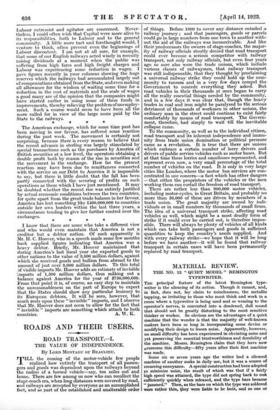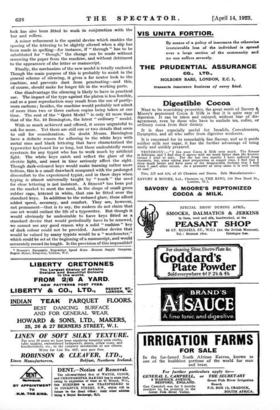MATERIAL REVIEW.
THE NO. 12 " QUIET MODEL " REMINGTON TYPEWRITER.
THE principal feature of the latest Remington type- writer is the silencing of its action. Though it cannot, and, in fact, does not, lay claim to noiselessness, the metallic tapping, so irritating to those who must think and work in a room where a typewriter is being used and so wearing to the operator's nerves, is converted into a deadened, dull sound that should not be greatly disturbing to the most sensitive thinker or worker. So obvious are the advantages of a quiet machine that the wonder is that the majority of well-known makers have been so long in incorporating some device or modifying their design to lessen noise. Apparently, however, no small difficulty has been experienced in obviating noise and yet preserving the essential trustworthiness and durability of the machine. Messrs. Remington claim that they have now overcome this difficulty—fifty years after their first machine was made.
Some six or seven years ago the writer had a silenced machine of another make in daily use, but it was a source of recurring annoyance. A special construction had been adopted to minimize noise, the result of which was that if a fairly high speed was attained, the type did not spring back to rest sufficiently quickly when released, and the type bars became " jammed." Then, as the bars on which the type was soldered were rather thin, they were liable to be beilt. and so one or
more letters would be put out of alignment. For a time a mechanic was brought in to restore order in the dishevelled ranks, but soon the machine was discarded when urgent work had to be done, and gradually allegiance was transferred again to a noisier but more dependable machine.
Therefore it was in extremely critical mood that we viewed the " Quiet Model " Remington.* But there seems no cause for distrust. Whatever the method adopted by this company to reduce the noise, it does not lie in any drastic alteration in the working of the type bars. The type operates in the same way as on the standard machine, hitting upwards on to the platen, and falling back into position immediately when released. Speed is obviously not sacrificed to silence. Indeed, so far from this being the case, in this latest design a number of minor improvements and adjustments are included that assist in attaining added speed. Chief among these is the " self-starter "—an improved form of tabulator by means of which a desired point on the paper can be reached from either side of the paper by merely depressing one of the five tabulator keys ; this is of particular value to a typist whose chief work is letter-writing. By using the " self-starter " letters can be typed in a uniform manner, and considerable time saved in indenting for address, paragraphs, complimen- tary ending, the title of the person signing, &c. The carriage- return lever is also lengthened and so shaped that the hand has to be raised but slightly from the keyboard to operate it, which makes for speed.
A very welcome improvement is the method adopted to hold the paper in position on the platen. In this " Quiet Model " a metal bar running the length of the carriage fitted with two long rubber rollers replaces the small paper fingers, which have on earlier models been placed one at either end of the carriage. Primarily this is, no doubt, intended to hold the paper more taut against the rubber platen, and so lessen the sound of impact, but it also has the added advantage of ensuring accurate alignment ; an improved feed roll release
• Remington Typewriter Company, 100 Gracechurch Street, London, E.C.
(Continued on page 638.) lock has also been fitted to work in conjunction with the bar and rollers.
A minor refinement is the special device which enables the spacing of the lettering to be slightly altered when a slip has been made in spelling—for instance, if " through " has to be substituted for " though," the change can be made without removing the paper from the machine, and without detriment to the appearance of the letter or manuscript.
Finally, the mechanism of the new model is totally enclosed. Though the main purpose of this is probably to assist in the general scheme of silencing, it gives a far neater look to the machine, and prevents dust from penetrating—and this, of course, should make for longer life in the working parts.
One disadvantage the silencing is likely to have in practical use. The impact of the type against the platen is less forcible, and so a poor reproduction may result from the use of partly- worn carbons ; besides, the machine would probably not admit of more than two or three carbon copies being taken at one time. The cost of the " Quiet Model " is only £2 more than that of the No. 10 Remington, the latest " ordinary " model.
With so much achieved and offered, it seems ungrateful to ask for more. Yet there are still one or two details that seem to call for consideration. No doubt Messrs. Remington have a definite reason for adhering to the white keys with metal rims and black lettering that have characterized the typewriter keyboard for so long, but these undoubtedly mean eyestrain for any typist who has to work much by artificial light. The white keys catch and reflect the glare of the electric light, and must in time seriously affect the sight. Though dark-coloured keys would make learning rather more tedious, this is a small drawback compared with the prolonged discomfort to the experienced typist, and in these days when typing is almost universally taught by " touch " the need for clear lettering is not insistent. A fitment* has been put on the market to meet the need, in the shape of small green rubber caps, lettered in white, that can be fitted over the standard keys. In-addition to the reduced glare, these afford added speed, accuracy, and comfort. They are, however, not permanent—that is to say, the makers do not claim that one set would outlast the life of a typewriter. But though it would obviously be undesirable to have keys fitted as a standard device that would periodically have to be renewed, we cannot see any good reason why a solid " cushion " key of dark colour could not be provided. Another device that would be valued by many typists would be a " wordometer," which could be set at the beginning of a manuscript, and would accurately record its length. Is the provision of this impossible?
• Munson's Pneumatic Typewriter Speed Keys. Munson Supply Company, Regent House, Kingsway, -London, W.C.












































 Previous page
Previous page